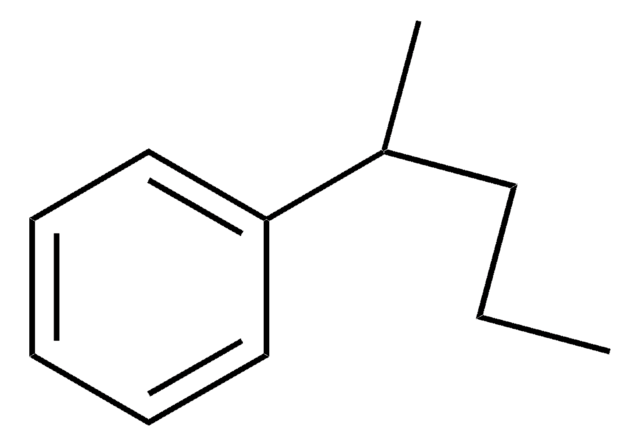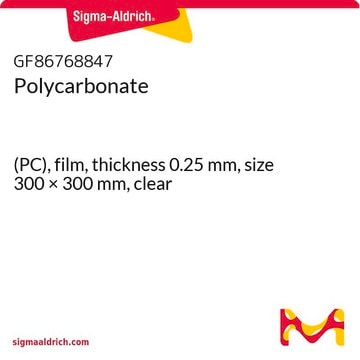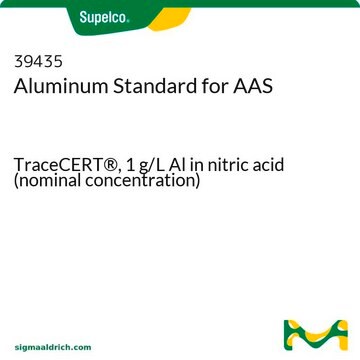GF64700524
Aluminum
rod, 1000mm, diameter 5.0mm, as drawn, 99.999%
Synonym(s):
Aluminum, AL007901
Sign Into View Organizational & Contract Pricing
All Photos(2)
About This Item
Empirical Formula (Hill Notation):
Al
CAS Number:
Molecular Weight:
26.98
MDL number:
UNSPSC Code:
12141702
PubChem Substance ID:
NACRES:
NA.23
Recommended Products
Assay
99.999%
form
rod
autoignition temp.
1400 °F
manufacturer/tradename
Goodfellow 647-005-24
resistivity
2.6548 μΩ-cm
L × diam.
1000 mm × 5.0 mm
bp
2460 °C (lit.)
mp
660.37 °C (lit.)
density
2.7 g/mL at 25 °C (lit.)
SMILES string
[Al]
InChI
1S/Al
InChI key
XAGFODPZIPBFFR-UHFFFAOYSA-N
General description
For updated SDS information please visit www.goodfellow.com.
Legal Information
Product of Goodfellow
Storage Class Code
13 - Non Combustible Solids
WGK
WGK 3
Flash Point(F)
Not applicable
Flash Point(C)
Not applicable
Certificates of Analysis (COA)
Search for Certificates of Analysis (COA) by entering the products Lot/Batch Number. Lot and Batch Numbers can be found on a product’s label following the words ‘Lot’ or ‘Batch’.
Already Own This Product?
Find documentation for the products that you have recently purchased in the Document Library.
Ryan J Mailloux et al.
Experimental cell research, 317(16), 2231-2238 (2011-07-27)
Aluminum (Al) is a metal toxin that has been implicated in the etiology of a number of diseases including Alzheimer's, Parkinson's, dialysis encephalopathy, and osteomalacia. Al has been shown to exert its effects by disrupting lipid membrane fluidity, perturbing iron
Todd D Terhune et al.
Journal of immunotoxicology, 10(2), 210-222 (2012-09-13)
Aluminum-containing adjuvants increase the effectiveness of vaccination, but their ability to augment immune responsiveness also carries the risk of eliciting non-target responses, especially in genetically susceptible individuals. This study reviews the relevant actions of aluminum adjuvants and sources of genetic
J R Walton
Journal of Alzheimer's disease : JAD, 29(2), 255-273 (2012-02-15)
Most humans living in industrialized societies are routinely exposed to bioavailable aluminum salts in the form of additives-in commercially-prepared foods, alum-clarified drinking water, certain pharmaceuticals, sunscreens, and other topical applications. Minute amounts of this aluminum are absorbed into the circulation.
Rejane C Marques et al.
Environmental pollution (Barking, Essex : 1987), 187, 130-135 (2014-02-04)
We studied neurodevelopment in infants from two communities. Children living in the vicinity of tin-ore kilns and smelters - TOKS; n = 51) were compared to children from a fishing village (Itapuã; n = 45). Mean hair-Hg (HHg) concentrations were significantly higher in Itapuã
Jian-Yong Li et al.
Proceedings of the National Academy of Sciences of the United States of America, 111(17), 6503-6508 (2014-04-15)
Aluminum (Al) toxicity is a major constraint for crop production on acid soils which compose ∼ 40% of arable land in the tropics and subtropics. Rice is the most Al-tolerant cereal crop and offers a good model for identifying Al
Our team of scientists has experience in all areas of research including Life Science, Material Science, Chemical Synthesis, Chromatography, Analytical and many others.
Contact Technical Service





